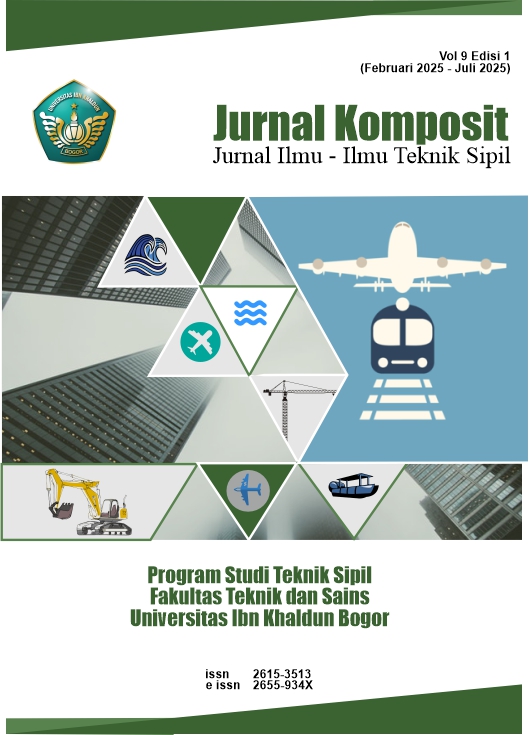Analisis Pemilihan Moda Transportasi Bagi Mahasiswa Universitas Sultan Ageng Tirtayasa
DOI:
https://doi.org/10.32832/komposit.v9i1.16446Keywords:
Mode Selection Transportation, Private Transportation, Public Transportation, Stated PreferenceAbstract
Sultan Ageng Tirtayasa University (Untirta) has an increasing number of students every year, causing traffic jams. One way to overcome this problem is to know the characteristics of student movements in traveling, especially in choosing the mode of transportation to be used. This study aims to observe the characteristics of transportation users traveling to campus and to analyze a mode selection model.This research was conducted with data from observations, questionnaire results, literature review, and data processing using the SPSS program with the Stated Preference method and the binomial logit model. The attributes used are cost (X1), travel time (X2), service convenience (X3), safety and security (X4). The results of the survey data The characteristics of the respondents in this study were 68% of the respondents were female with the majority of the age range 21-23 years as much as 71%, more respondents traveled to campus in 20-40 minutes by 46%, the mode of transportation most often used to visit campus is a motorcycle, reaching 54%. Travel time is the factor that most influences the choice of mode of transportation. The reason for choosing a mode is that many respondents choose a mode of transportation based on the fare attribute for private transport, namely 72.1% and for public transportation, namely 27.9%. Based on the time attribute, the probability of students choosing private transportation is 71.2% and public transportation is 28.8%. Based on the convenience attribute, the probability of students choosing private transportation is 71.6% and public transportation is 28.4%. Based on safety and security attributes, the probability of students choosing private transportation is 74% and public transportation is 26%.
References
Alkam, R. B. (2019). Pengaruh Variasi Waktu Pembebanan Terhadap Sifat Reologi Visco-Elastic Aspal Pen 80/100 Dengan Penambahan Asbuton Murni. Jurnal Teknik Sipil, 14(4), 208–218. https://doi.org/10.24002/jts.v14i4.1996
Argarisma, A., & Naipospos, B. P. (2023). Peningkatan Penggunaan Moda Non-Motorized Transport dengan Stated Preference pada Pelajar Sekolah Menengah Negeri Jakarta Pusat. Jurnal Komposit: Jurnal Ilmu-Ilmu Teknik Sipil, 7(2), 183–191. https://doi.org/10.32832/komposit.v7i2.14520
BPS Kota Serang. (2021). Kota Serang dalam Angka. Kota Serang Dalam Angka, 260. https://serangkota.bps.go.id/id/publication/2021/02/26/92d07f0edc333af1889f4a49/kota-serang-dalam-angka-2021.html
Budiman, A., Bethary, R. T., & Hilzams, F. F. (2022). Analisis Pemilihan Moda Transportasi Mahasiswa Fakultas Teknik Untirta (Studi Kasus Cilegon-Tangerang). Fondasi : Jurnal Teknik Sipil, 11(1), 13. https://doi.org/10.36055/fondasi.v0i0.14502
Dita, A., Putri, K., Al, K., & Nisumanti, S. (2022). Pemilihan Moda Transportasi Kereta Api Menuju Pelabuhan Bakauheni di Propinsi Lampung. Rekayasa Jurnal Ilmiah Fakultas Teknik Universitas Lampung, 26(2), 44–48. https://rekayasa.ft-sipil.unila.ac.id/index.php/rjits/article/view/63
Dodi, D., & Nahdalina, N. (2019). Analisis Pemilihan Moda Transportasi Dengan Metode Discrete Choice Model (Studi Kasus: Bandara Internasional Soekarno Hatta). Warta Ardhia, 44(2), 81–92. https://doi.org/10.25104/wa.v44i2.334.81-92
Kawengian, E., Jansen, F., & Rompis, S. Y. R. (2017). Model Pemilihan Moda Transportasi Angkutan dalam Provinsi. Jurnal Sipil Statik, 5(3), 133–142. https://www.journal.unrika.ac.id/index.php/jurnalphythagoras/article/view/2560
Nalendra, A. R. A., Rosalinah, Y., Priadi, A., Subroto, I., Rahayuningsih, R., Lestari, R., Kusamandari, S., Yuliasari, R., Astuti, D., Latumahina, J., Purnomo, M. W., & Zede, V. A. (2021). Stastitika Seri Dasar dengan SPSS. In Media Sains Indonesia: Bandung.
Nur, N. K., Rangan, P. R., & Mahyuddin. (2021). Sistem Transportasi. In Penerbit Yayasan Kita Menulis (Vol. 1, Issue 69). https://kitamenulis.id/2021/08/05/sistem-transportasi/
Oktaviani, O., & Pebriani, M. (2023). Karakteristik Pemilihan Moda Transportasi Menuju Kampus (Studi Kasus: Mahasiswa Fakultas Teknik Universitas Negeri Padang). Cived, 10(2), 474–483. https://cived.ppj.unp.ac.id/index.php/CIVED/article/view/403
Purwanti, O., Kurniautami, U. N., & Maulana, A. (2019). Analisis Pemilihan Moda Transportasi di kampus Itenas. Jurnal Transportasi Multimoda, 16(1), 43–50. https://doi.org/10.25104/mtm.v16i1.836
Putri, N. I. P. (2022). Pengaruh Transportasi Umum Terhadap Perkembangan Antar Wilayah Administrasi di Jakarta. Jurnal Manajemen Bisnis Transportasi Dan Logistik, 8(1), 63. https://doi.org/10.54324/j.mbtl.v8i1.1249
Septami, I. D., Agustin, I. W., Meru, D., Jurusan, U., Wilayah, P., & Kota, D. (2019). Pemodelan Pemilih Moda Angkutan Umum di Kota Mataram. Planning for Urban Region and Environment, 8(3), 97–104. https://purejournal.ub.ac.id/index.php/pure/article/view/320
Sitanggang, R., Saribanon, E., & Trisakti, I. (2018). Faktor-Faktor Penyebab Kemacetan di DKI Jakarta. Jurnal Manajemen Bisnis Transportasi Dan Logistik, 4, 289–296. https://journal.itltrisakti.ac.id/index.php/jmbtl/article/view/823
Sukarmi, S., & Suwondo, D. (2019). Kebijakan Penggunaan Moda Transportasi Umum untuk Kesejahteraan Ekonomi Masyarakat Kota Semarang. Masalah-Masalah Hukum, 48(2), 194. https://doi.org/10.14710/mmh.48.2.2019.194-203
Sumampouw, G. R. O., Lefrandt, L. I. R., & Rompis, S. Y. R. (2022). Analisis Pemilihan Moda Transportasi di Kabupaten Minahasa Utara. Tekno, 20(81), 353–362. https://ejournal.unsrat.ac.id/index.php/tekno/article/view/43358
Tamin, O. Z. (2008). Perencanaan dan Pemodelan Transportasi. ITB. https://www.itbpress.id/product/perencanaan-dan-pemodelan-transportasi-edisi-kedua/
Downloads
Published
How to Cite
Issue
Section
License
Copyright (c) 2025 Jurnal Komposit: Jurnal Ilmu-ilmu Teknik Sipil

This work is licensed under a Creative Commons Attribution-NonCommercial-ShareAlike 4.0 International License.
Authors who publish with this journal agree to the following terms (Penulis yang mengajukan publikasi artikel telah menyetujui hal berikut):
- Through this publication, the author agree to submit the copyright of article writing to Jurnal Komposit: Jurnal Ilmu-ilmu Teknik Sipil. This copyright submission takes the form of, but is not limited to: reproduction of the article and parts therein, including photographic reproductions; distribution of articles through printed and electronic documents; and translation of articles(Bahwa melalui publikasi ini, hak cipta penulisan artikel diserahkan kepada Jurnal Komposit: Jurnal Ilmu-ilmu Teknik Sipil. Penyerahan hak cipta ini berupa, namun tidak terbatas pada: perbanyakan artikel dan bagian di dalamnya, termasuk reproduksi fotografi; penyebarluasan artikel melalui dokumen cetak dan elektronik; serta penterjemahan artikel).
- The authors agree to the terms of the Copyright Notice, according to Creative Commons Attribution-NonCommercial-ShareAlike 4.0 International License., which will apply to this article if and when it is published by Jurnal Komposit: Jurnal Ilmu-ilmu Teknik Sipil. (Para penulis setuju dengan ketentuan Pemberitahuan Hak Cipta, sesuai dengan Lisensi Internasional Creative Commons Attribution-NonCommercial-ShareAlike 4.0., yang akan berlaku untuk artikel ini jika dan ketika diterbitkan oleh Jurnal Komposit: Jurnal Ilmu-ilmu Teknik Sipil).

This work is licensed under a Creative Commons Attribution-NonCommercial-ShareAlike 4.0 International License.



.png)










